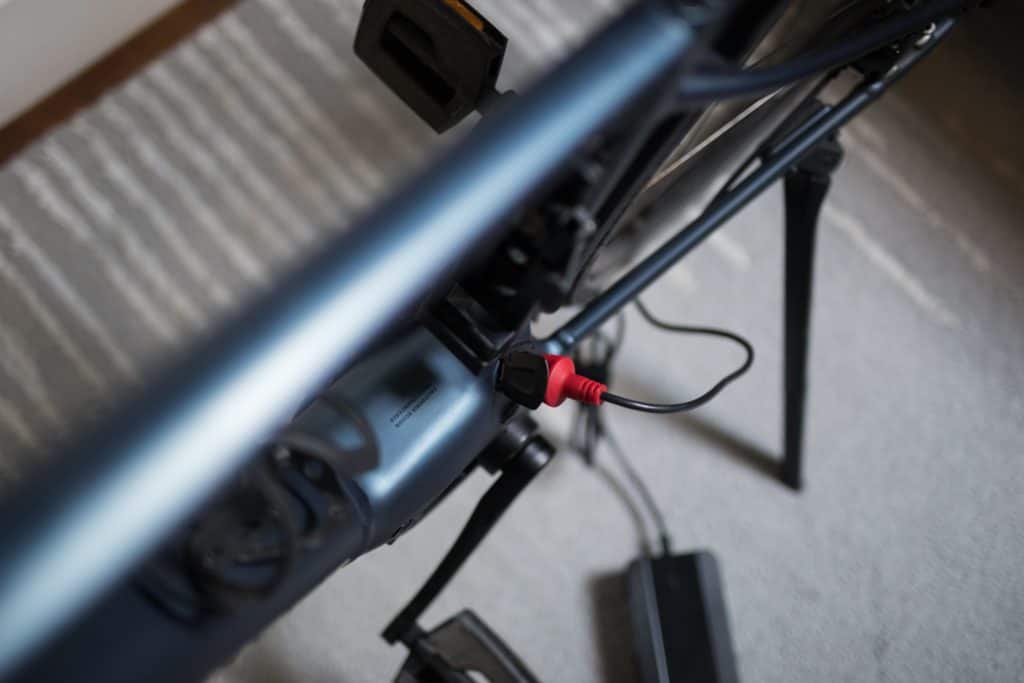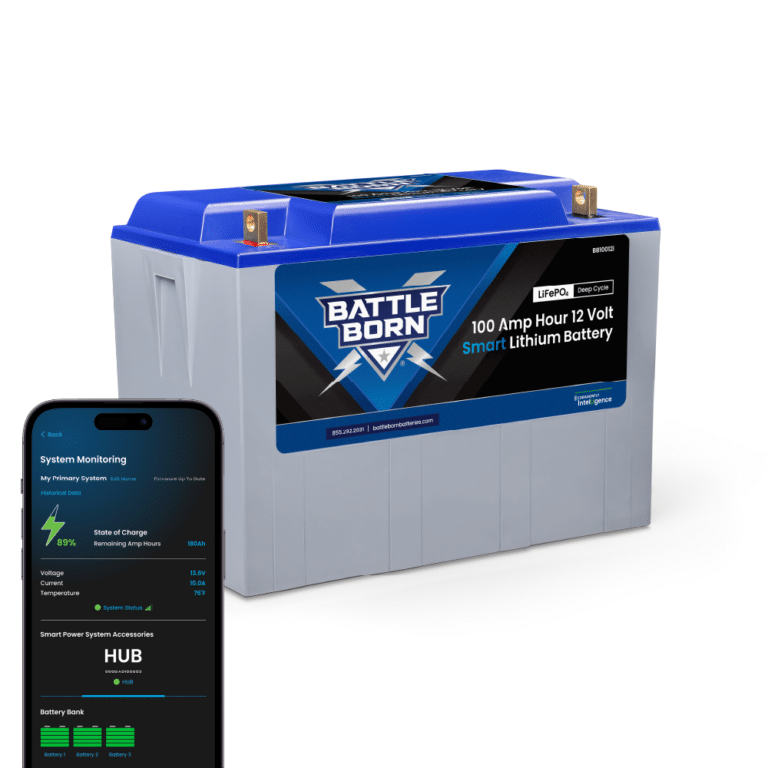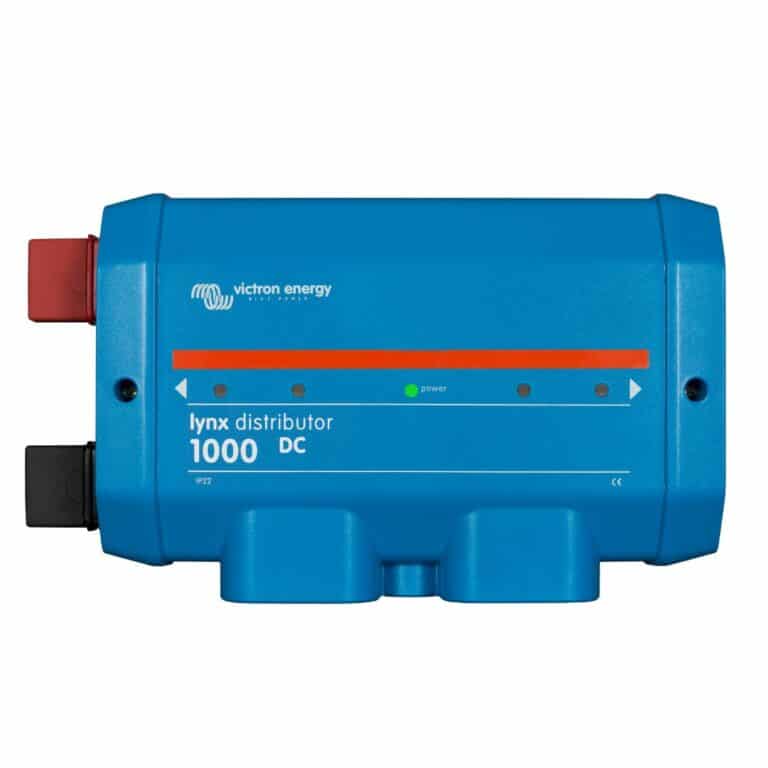
MENUMENU
TALK TO AN EXPERT
Special Hours: 7AM – 6PM PST
TALK TO AN EXPERT
Special Hours: 7AM – 6PM PST
It seems no matter where you camp these days, you’ll see an e-bike whizzing by your campsite. Riding the bike is the easy part, but dealing with charging an e-bike in a motorhome can be difficult. It brings on a whole new element when it comes to your electrical system.
Let’s look at whether or not you can charge e-bikes in a motorhome or when camping.
Yes, if you’re at a campsite with electric hookups, it likely won’t be a problem. It’s easy to charge e-bikes in motorhomes or RVs after a long day of using them. By the next day, your e-bike will be ready to go.
If you’re not camping with hookups, you can still charge your e-bike with your motorhome or RV. Most e-bikes are pretty efficient, just sipping power instead of gulping it. Many e-bikes also have an automatic shut-off installed, so they don’t continue charging after full. That way, you can set it and forget it.
If you want to charge from solar power you might need to make some adaptations, such as using an inverter to convert DC voltage to AC, so keep that in mind before heading out.

The amount of power you’ll need to charge your e-bike is primarily determined by how powerful of an e-bike you have. Larger e-bikes that can go longer distances, faster speeds, and carry more weight require more power to charge them.
Typically an e-bike battery will require 500-800 watt-hours for a full charge. Many e-bikes use lithium-ion batteries, which can charge incredibly fast. A fully depleted lithium-ion battery can take anywhere from 3.5 to 6 hours to recharge.
But if the bike uses lithium-ion batteries, you don’t always need to recharge to 100%. The battery charges to 90 percent capacity very quickly, and the last 10% takes much longer because it charges at a lower wattage. So, depending on the lithium battery size, your e-bike could be at 90% after approximately 2.5 hours and is ready to use!

Camping with an e-bike can be both practical and incredibly fun. However, not all campsites will gift you access to unlimited power. If you prefer off-grid camping, you’ll have to find your own means of charging the battery. Let’s look at a few popular ways to charge your e-bike when camping.
This is one of the most common ways RVers charge their e-bikes while camping. If you’re plugging your RV into a power pedestal, you likely won’t have to worry about a power source. There are rare circumstances where the power is out to the campground, but for the most part, you’ll practically have an unlimited supply of power to charge your e-bike and other electronics.
Charging things with solar power is super cool. Solar panels can create significant power that RVers often use to charge their RV’s battery bank on a clear day. However, you could use this same technology to charge your e-bike.
You’ll need a solar panel, a charge controller, RV battery bank, inverter, and, of course, an e-bike battery. This charging method is excellent if you’re at your campsite, but it won’t do much good if you’re out and about. You likely won’t want to carry a solar panel and charge controller around with you, and it will take several hours to get a sufficient charge from it.
→ Read RV Solar Panels: A Guide For Beginners to get started with solar power!

You can use your motorhome battery bank to charge your e-bikes when off the grid. You will need an RV battery inverter to be able to do this and convert your battery’s 12V power to 110V AC that your e-bike battery charger needs. However, not all RV battery banks will be able to fully charge a 500-800 watt-hour e-bike battery without fully draining themselves or even causing damage.
For instance, two 12V lead-acid batteries have about 1200 watt-hours of usable energy at a low draw (less for high-powered appliances). They should not be drained below 50% capacity. This means that charging an e-bike battery in an off-grid motorhome would mostly drain those batteries if they were fully charged. Depending on how fast the e-bike charger draws, you could experience even less lead-acid battery capacity due to the Puekert effect.
Conversely, two 12V Battle Born lithium-ion batteries have about 2600 watt-hours of usable energy and can be drained 100% without damage. They also can handle heavier power draws without the Puekert effect.
Using batteries to charge batteries enables using “buckets” of power that can pass energy from one to another. Usually an RV battery bank has alternative energy sources like solar and generator to provide energy. Many times you want to charge an E-bike overnight and use it during the day. Using an RV battery bank can store solar energy from the day to charge the bike at night.

If you don’t have access to power but have a 12V system in your vehicle with an inverter, it could be an excellent option for charging your e-bike. Many newer vehicles include a 110V electrical plug for users, which can charge laptops, phones. Keep in mind that many of these inverters are too small for an E-bike. You might need to
It’s important to note; these systems can quickly drain a vehicle’s battery. You must keep the vehicle running while using this charging method. If not, there’s a good chance you’ll have a somewhat charged e-bike and a completely drained vehicle battery.
The loudest (and often most annoying) option is a generator to charge your e-bike. This is a popular method because generators are relatively inexpensive and can produce significant power. Many generators rely on gasoline to keep their engine running, but there are also diesel and propane generators.
Many inverter generators will include electrical outlets on them so that you can plug your e-bike battery directly into the generator. This will quickly charge your battery, and you’ll be back on your e-bike in no time.
Get in the habit of regularly charging your e-bike battery. If you charge it after every ride, you should be set. While you could fully discharge your e-bike’s lithium battery without causing permanent damage, try not to let it sit below 30% capacity. You don’t want to find yourself stranded because your e-bike’s battery couldn’t make the distance. Many e-bikes encourage users to rotate between charging at 30% and 60% to help increase an e-bike’s battery life and keep you safe on the road.
The most important feature of an e-bike is that it’s ready to go when you are. You don’t want to be waiting around for your e-bike to charge, so having a plan for keeping it charged will set you up for success.

Most electronics these days can shut down charging once a battery is full. If your e-bike has a lithium-ion battery, you should verify that you can leave your charger plugged in overnight. Overcharging any type of battery can cause serious damage to the battery, so make sure yours will automatically stop charging at full if you’re going to leave it plugged in overnight.
If you have any questions regarding your specific e-bike battery, consult your e-bike’s documentation or call customer service.
Yes, bringing an e-bike camping is definitely worth it. Whether you want to go for a relaxing ride around the campground or to scout out a potential boondocking spot, it’s a great tool to have on hand. Even if you see your e-bike as more of a toy than a tool, it can be a great way to enhance your camping experience.
You should check any local campground regulations regarding e-bikes before bringing one with you. You don’t want to discover that your campground prohibits riding e-bikes on the premises. As speeds increase with e-bikes, some campgrounds will have e-bike rules or even bans, so check the campground rules before you ride.
Overall, an e-bike can be a great way to get around a campground, travel into town, or go for a relaxing bike ride. E-bikes are flying off the shelves, and more and more RVers have found room for them in their storage bays. Having a solid plan for efficient power usage will take all the stress out of using your e-bike.

We know that building or upgrading an electrical system can be overwhelming, so we’re here to help. Our Reno, Nevada-based sales and customer service team is standing by at (855) 292-2831 to take your questions!
Also, join us on Facebook, Instagram, and YouTube to learn more about how lithium battery systems can power your lifestyle, see how others have built their systems, and gain the confidence to get out there and stay out there.
Shop Best Sellers








Ask a technical specialist now at 855.292.2831
Stay in the Know